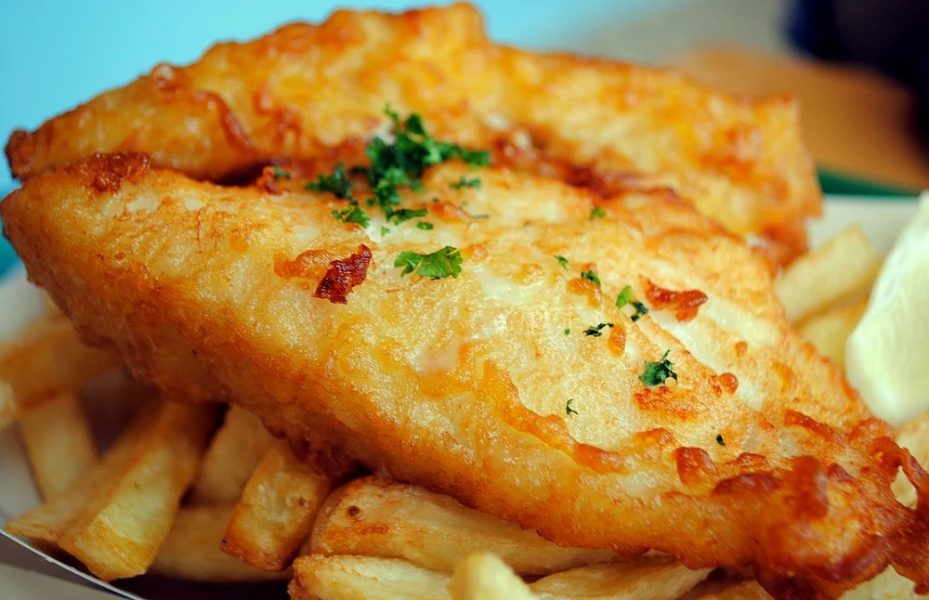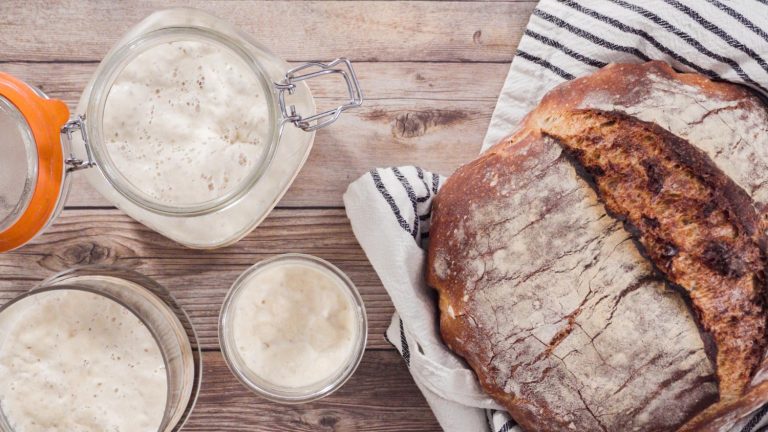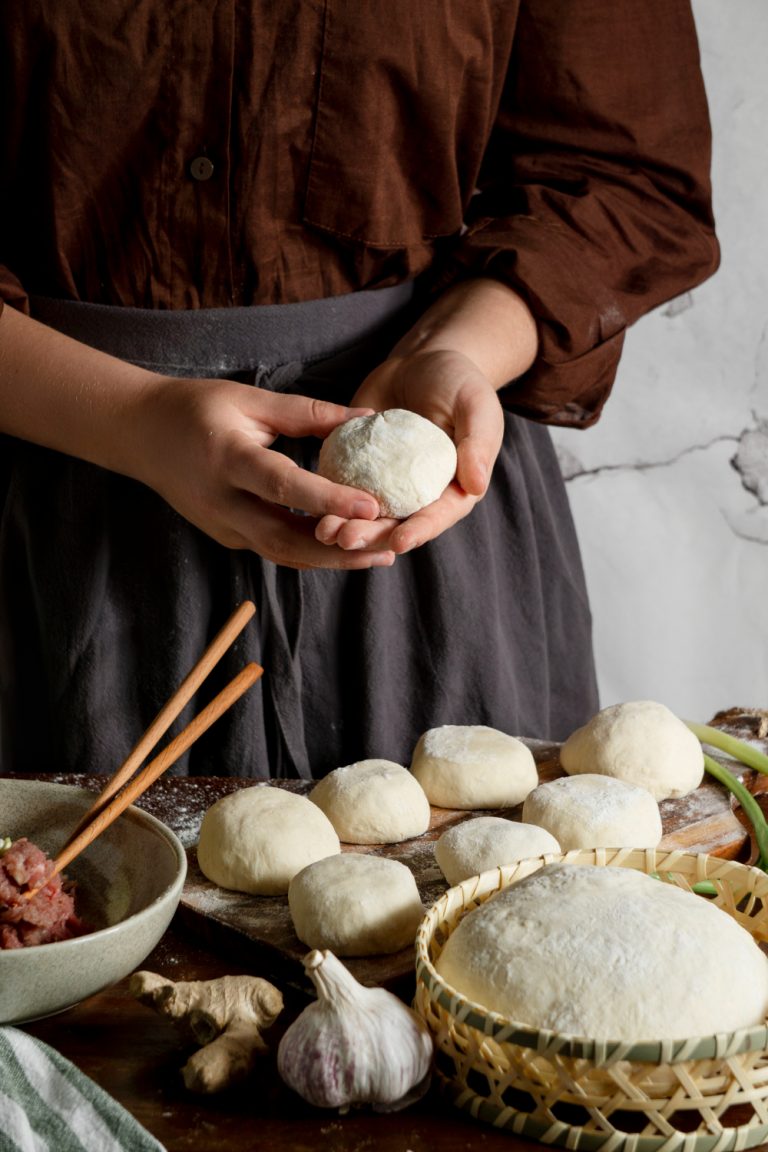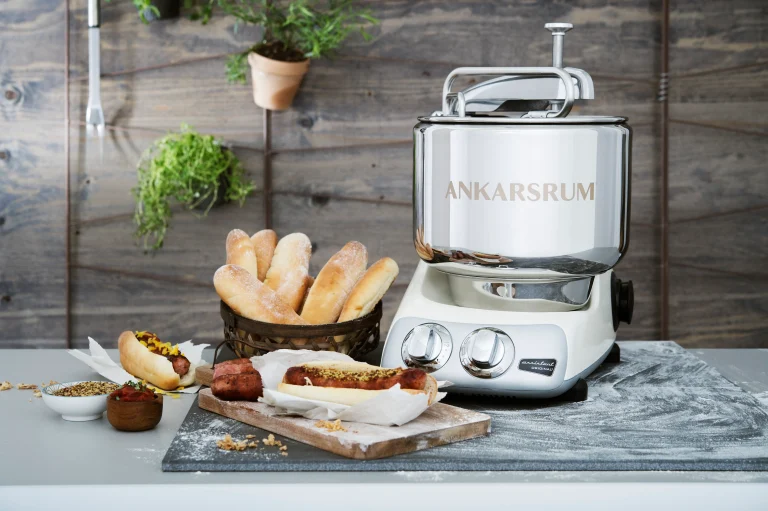How to Make the Best Sourdough Fish Batter for Crispy Fish & Chips
The perfect crispy fish and chips depends on an exceptional batter. Sourdough fish batter takes this classic dish to new heights. The tangy complexity of sourdough starter combines with a light, crispy texture that makes fish and chips irresistible. Your reward is a golden-brown crust that stays crispy longer than traditional batters and adds subtle flavor depth.
This detailed guide shows you how to create restaurant-quality fish and chips at home with sourdough starter or discard. You will learn the right techniques to select fish, mix perfect batter, and reach ideal frying temperature. The recipe delivers crispy results with beer battered flounder or other white fish varieties consistently.
Ingredients for Sourdough Fish Batter
The perfect sourdough fish batter depends on ingredients that blend together for a crispy exterior. Each ingredient plays a significant part in creating the batter’s texture and flavor.
Sourdough starter/discard
½ cup of sourdough starter or discard forms this batter’s foundation. Natural fermentation creates a complex flavor profile and produces a lighter, airier batter. Your cold starter will work perfectly straight from the refrigerator and helps maintain the batter’s ideal temperature.
Flour
The perfect blend of flours delivers an ideal texture:
- ¾ cup rice flour creates a crispy coating
- ½ cup all-purpose flour provides the base structure
- ¼ cup cornstarch adds extra crunchiness
Seasonings
This seasoning blend adds rich flavor to the batter and works perfectly with fish:
| Essential Seasonings | Amount |
|---|---|
| Salt | 2 teaspoons |
| Black pepper | 1 teaspoon |
| Paprika | 1 teaspoon |
| Garlic powder | 1 teaspoon |
Carbonated liquid (beer or seltzer water)
Carbonation plays a significant role in creating a light, crispy texture. Use 1¾ cups of either:
- Beer (amber varieties work well)
- Seltzer water or club soda
- Sparkling water
Adding 2 tablespoons of malt vinegar will develop more tang and flavor. Your batter should be thinner than pancake batter but thick enough to coat the back of a spoon. This combination will create a perfect coating that turns into a golden-brown crust during frying.
Add ¼ teaspoon of baking soda just before using the batter. The baking soda creates extra bubbles that help achieve the final crispy texture.
Preparing the Fish
Perfect fish preparation and handling are the foundations of achieving crispy results with sourdough fish batter. Selecting the right fish is crucial, and proper cleaning and portioning complete the preparation process.
Best Fish for Your Sourdough Batter
These three fish varieties deliver exceptional results with sourdough batter:
| Fish Type | Characteristics | Best For |
|---|---|---|
| Cod | Mild, tender meat | Maximum contrast between crispy exterior and delicate interior |
| Haddock | Sweeter, firmer texture | Better flavor profile |
| Pollack | Juicy, tender member of cod family | Perfect balance of flavor and texture |
Cleaning and drying the fish
Proper moisture management creates the crispiest results. You need to clean and dry your fish really well before adding the sourdough batter. These steps are crucial:
• Use paper towels to pat the fish dry
• Let it sit uncovered in the refrigerator up to an hour
• Take off any leftover scales or unwanted parts
• Clean the fish’s cavity really well if using whole fish
• Give it one final pat-dry before you add batter
Cutting into portions
The right portioning will give you even cooking and better batter adhesion. Cut the fish into uniform pieces about 4-5 inches long and 2-3 inches wide. Here’s what you need to do:
- Hold your knife at a 45-degree angle to get even portions
- Cut through the flesh with clean, decisive strokes
- Keep each piece’s thickness the same for consistent cooking
- Take out any remaining pin bones
- Cut away dark meat and fatty areas
Each portion should be 1-1.5 inches thick. This helps the fish cook well and stay moist. The uniform size means everything cooks at the same time, and you’ll get that amazing crispy exterior that makes sourdough battered fish so special.
Making the Sourdough Batter
Simple ingredients become perfect sourdough fish batter with attention to detail and proper technique. These precise steps will give a consistently crispy coating that lifts any fish dish.
Mixing the ingredients
A smooth, lump-free batter depends on how you mix the ingredients. Follow these steps:
- Take a large mixing bowl and whisk the dry flour to break up any lumps
- Make a deep well right in the middle of the flour mixture
- Pour your sourdough starter into the well
- Keep whisking as you slowly pour the carbonated liquid
- Add the groundnut oil and stir continuously
Achieving the right consistency
Your sourdough fish batter should match the consistency of thick gloss paint. Here are common consistency problems and their solutions:
| Issue | Solution |
|---|---|
| Too thick | Add carbonated liquid gradually while whisking |
| Too thin | Incorporate additional flour in small amounts |
| Lumpy | Continue whisking vigorously; lumps will eventually incorporate |
A perfect batter coats the back of a spoon smoothly and sticks well to the fish. Vigorous whisking will smooth out any stubborn lumps effectively.
Letting the batter rest
The batter’s resting time is a significant step many people skip. The batter needs 30 minutes to rest before use. This waiting period allows several changes to happen:
- The structure improves as gluten develops
- All ingredients absorb moisture properly
- The flavors blend together
- Small air bubbles form naturally
The batter’s temperature affects its final texture. The best results come when you keep the batter at 70-75°F (21-24°C) while it rests. A gentle stir with baking powder right before cooking creates extra bubbles that make the signature crispy texture.
Frying for Perfect Crispy Fish
Perfect crispy fish depends on becoming skilled at a significant final step: the frying process. Restaurant-quality results come from well-prepared sourdough batter, portioned fish and careful temperature control with proper technique.
Oil temperature
The perfect crisp depends on temperature control as its life-blood. Your sourdough battered fish needs 375°F (190°C) as the ideal frying temperature. The following stages require monitoring:
| Stage | Temperature | Action |
|---|---|---|
| Original heating | 400°F | Prepare for temperature drop |
| Frying range | 375-350°F | Maintain within this range |
| Recovery time | 375°F | Allow oil to reheat between batches |
A candy or deep-frying thermometer helps you maintain consistent temperature as you cook.
Dipping and frying technique
A proper frying technique will give you evenly cooked and super crispy results. Here’s what you need to do:
- Take your fish piece and dip it in the batter. Let any extra batter drip off
- Grab one end of your battered fish and slide it gently across the oil’s surface
- The oil will start to sizzle. That’s your cue to lower the whole piece into the hot oil
- Let it cook for 3-4 minutes until it turns deep golden brown
- Use a spider skimmer to flip it carefully
- Give it another 3-4 minutes to cook the other side
- You’ll know it’s ready when you see the bubbles starting to slow down
Draining excess oil
The right draining technique plays a significant role to achieve crispy sourdough batter coating. A wire rack set inside a rimmed baking sheet serves as the quickest way to drain. This setup gives you:
- Air circulation around the entire piece
- Prevention of steam buildup
- Continuous oil draining
- Maintenance of crispiness
The fish needs seasoning right after it comes out of the hot oil. The crispy exterior will suffer if you cover the fried fish because steam gets trapped underneath. Your sourdough batter has unique properties that keep the fish crispy longer than regular batters. This makes it perfect to serve immediately or hold for a short time.
Small batches yield the best results and help you control the oil temperature better. You’ll know the fish is ready when it flakes easily with a fork and looks opaque throughout.
Conclusion
The perfect sourdough fish batter requires careful attention at each significant step. Quality ingredients and precise frying temperatures play a vital role in the process. Your success depends on proper moisture management, consistent batter control, and expert frying techniques. These elements combine to create fish and chips with an exceptional crispy coating that remains crunchy longer while the delicate fish stays perfectly cooked inside.
Sourdough’s versatility extends far beyond fish and chips into numerous culinary adventures. This traditional technique can improve modern cooking substantially. Creative home cooks will discover endless opportunities to craft exceptional dishes. [You can lift your bread and pizza game with an authentic artisanal sourdough starter from The Yeast We Can Do – email john@theyeastwecando.com to get your hands on our premium sourdough starter, perfect for passionate home bakers and restaurant owners looking to add true sourdough character to their menu.] The right technique and quality ingredients will help you achieve restaurant-quality results that will amaze your family and guests.
FAQs
What are the typical ingredients used in fish and chips batter?
The batter for fish and chips generally consists of flour, baking powder, salt, and pepper. These dry ingredients are mixed together, then milk and an egg are added to achieve a smooth consistency. The batter should rest for about 20 minutes before use. During this time, oil should be heated to 350 degrees F (175 degrees C) for frying.
How can I ensure the batter adheres well to the fish when frying?
To ensure the batter sticks to the fish, use a combination of all-purpose flour and yellow cornmeal for the breading mixture. This combination provides the classic gritty texture. Adding a heaping tablespoon of cornstarch is crucial as it helps the batter adhere better to the fish.
Which type of flour yields the crispiest result for fried fish?
For a crispy texture in fried fish that isn’t as grainy as cornmeal, opt for semolina flour or stone-ground wheat flour. These flours provide a desirable crunchiness to the fried fish.
Why might my fish batter turn out soggy rather than crispy?
A soggy batter can result from over-mixing, which develops too much gluten and causes the batter to absorb excess oil. To avoid this, mix the batter just enough to combine the ingredients, and be sure not to use warm water.
Can sourdough starter be used in fish batter?
Yes, using sourdough starter for the fish batter can be a fantastic choice. It adds a unique flavor and texture to the batter, enhancing the overall taste of fried fish dishes such as tacos.






